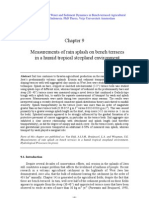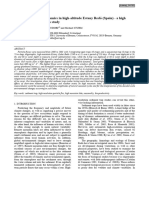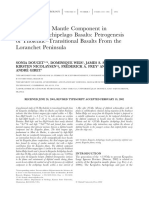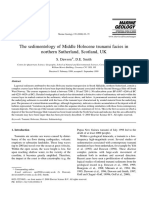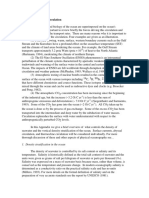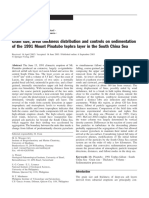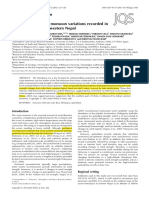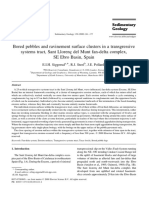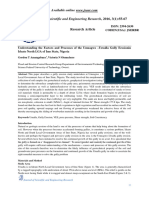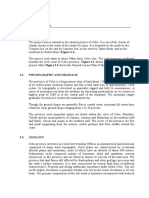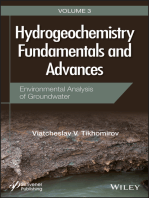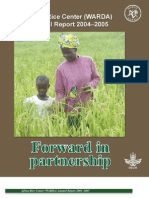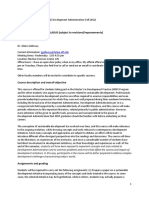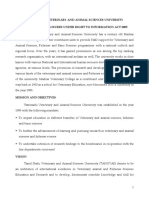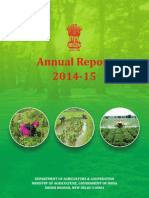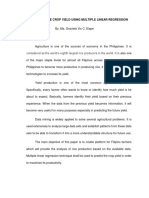Study Area
Study Area
Uploaded by
SudharsananPRSCopyright:
Available Formats
Study Area
Study Area
Uploaded by
SudharsananPRSOriginal Title
Copyright
Available Formats
Share this document
Did you find this document useful?
Is this content inappropriate?
Copyright:
Available Formats
Study Area
Study Area
Uploaded by
SudharsananPRSCopyright:
Available Formats
A.I.J.M. van Dijk (2002) Water and Sediment Dynamics in Bench-terraced Agricultural Steeplands in West Java, Indonesia.
PhD Thesis, Vrije Universiteit Amsterdam
Chapter 3 Study area
3.1. Geology and physiography CHERPs research is carried out in a 125 ha upland catchment situated on the footslopes of the inactive Cakrabuana volcano, 6 km north of the town of Malangbong and about 40 km east of the provincial capital Bandung, West Java. The catchment constitutes the headwater area of the Cikumutuk, a tributary to the large Cimanuk river that drains a large portion of West Java. The catchment lies at an altitude of 560 to 740 m a.s.l. (7E03S, 108E04W) and slopes are generally fairly steep at 15-20E on average (Fig. 3.1). Java is one of the islands of the Sunda arc, an array of islands created by upheaval and volcanic activity associated with the Indian Ocean Plate that plunges beneath the Eurasian Plate at an estimated rate of 6 cm yr-1 (Hamilton, 1979). Van Bemmelen (1949) divided West Java into four zones of contrasting genesis, viz. from South to North (Fig. 3.2a): (i) marine deposits lifted by the subducting plate; (ii) a central depression zone with more or less isolated volcanoes and deposits derived from these; (iii) a second range of lifted sedimentary deposits (the Bogor zone); and (iv) an alluvial plain, made up of rather young sediments eroded from the more mountainous areas to the south. A SouthNorth cross section shows that the Cikumutuk catchment lies within the central volcanic zone (Fig. 3.2b). In more detail, the geology of the study catchment is made up of Pliocene to Pleistocene volcanic agglomerates (breccias), which have been covered by more recent Holocene volcanic andesitic ash. Both deposits presumably originate from the nearby Mount Cakrabuana (Budhitrisna, 1987). The breccias are highly weathered and exposed mainly as clayey saprolite (rotten rock) or as truncated Pliocene to Pleistocene red lateritic palaeosols. Large porphyritic boulders are found near the top of these palaeosols, some of which protrude through the covering ash deposits, particularly on and near ridges in the landscape. The breccia has been moved over varying vertical distances in a block-faulted fashion. On top of the faulted breccias, roughly 1.5 metres of volcanic ash were originally deposited. Thin pebble horizons and the accumulation of more gravely deposits at the bottom of hillslopes suggest that overland flow and surface erosion have occurred between eruptions, perhaps under a drier, more seasonal climate (Verstappen, 1974). The ash has weathered to a massive silty clay or clay loam with little original minerals remaining, while the top decimetres of this material have a much more permeable, aggregated structure. On the steeper parts of the hillsides, much of the loose topsoil has been eroded, leaving only the more massive subsoil or even cutting into the underlying breccias. Despite the massive matrix of the older ash and weathered breccias,
21
CHAPTER 3 - STUDY AREA
Fig. 3.1. Location of the Cikumutuk catchment and the various experimental sites. The water balance study was carried out close to terraces plots E and F (code EF), whereas laboratory experiments were carried out near the climatological station (code CS).
the movement of most of the infiltrated rainfall through the soil and the groundwater reservoir is rapid, as evidenced by the fast drainage of the soil (Chapter 6) and the quick response of the groundwater table and recession of stream base flow (A.I.J.M. van Dijk, unpublished data). The weathered breccias act as the local groundwater aquifer and ephemeral springs are often found close to the interface between weathered and unweathered breccias. There are two permanent springs in the catchment. Interpretation of aerial photographs as well as geophysical and hydrochemical surveys indicate a fault line along which one of the springs is fed from outside the catchment, thereby boosting dry season flows somewhat (A.I.J.M. van Dijk, unpublished data). A generally dendritic drainage pattern that is strongly influenced by fault lines has developed, with the Cikumutuk itself being the only permanent stream.
22
CHAPTER 3 - STUDY AREA
(a)
(b)
Fig. 3.2. (a) Generalised geology of West Java and (b) South-North cross-section, including the study area.
3.2. Soils In earlier surveys, the soils found in the catchment were all classified according to USDA taxonomy as Orthox soils. A catena of sub-types was found, from Haplorthox soils on and near the ridge tops, via Rhodortox and Chromorthox soils on the steeper slopes to Oxorthox soils in the valley bottoms (Purwanto, 1999). In the more commonly used Indonesian Soil Classification System (Soepraptohardjo, 1961) these soils are categorised as Reddish Brown or Red Latosols (Subardja and Buurman, 1980). The geology and soils of the catchment can be considered representative of many other predominantly agricultural areas in volcanic upland West Java. Latosols are the most common volcanic soils in Java and are generally developed in Pliocene to lower-
23
CHAPTER 3 - STUDY AREA
Fig. 3.3. Distribution of volcanic Latosols and other volcanic and Latosols soils in West Java.
100
Fraction finer (%)
wet-sieved
50
oven-dry
0 100
1,000
Particle size ( : m)
10,000
Fig. 3.4. Oven-dry and wet-sieved aggregate size distributions of samples taken from the topsoil (0-10 cm) near terraces E and F (cf. Fig. 3.1).
Holocene volcanic tuffs (Oldeman and Frre, 1982; Fig. 3.3). All soils within the catchment consist mainly of silt and clay and have kaolinite as the dominant clay mineral (P.P. Hehuwat, pers. comm.), suggesting a fairly advanced stage of weathering (Mohr et al. 1972). The soils involved in most field measurements and experiments consist of a rather massive clay-loam subsoil overlain by a loose silty clay topsoil with very little sand (ca. 70% clay, 30% silt; Fig. 3.4). The thickness of this upper layer varies because of the bench terraces that have been carved in the hillsides, between 10 and 70 cm on the terrace beds and between 0 and 70 cm on the terrace risers. The top 10 cm shows a median dispersed particle size of 1.2 :m (laser grain size analysis; Konert and Vandenberghe, 1997). The topsoil is well-aggregated, with the crumbly sub-angular aggregates sometimes reaching a diameter of more than 8 mm and with a median dry-
24
CHAPTER 3 - STUDY AREA
600 500
Monthly rainfall (mm)
400 300 200 100 0 J F M A M J J A S O N D
Fig. 3.5. Average monthly rainfall in the study area between 1994 and 2001 (dotted lines indicate one standard deviation from the mean).
sieved aggregate size of 3.2 mm (see also front cover). The median size of water-stable aggregates of the topsoil was determined through wet sieving at ca. 1.1 mm (see Fig. 3.4). Oven-dry bulk density of the top layer is 0.92 (standard deviation "0.09) kg dm-3 and porosity very high at 64 ("8)%. The cation exchange capacity is low at 9.7 ("0.1) meq mg-1, with a base saturation of 32 ("1)%. More detailed descriptions of reference soil profiles can be found in Purwanto (1999), while details on soil hydrological characteristics (notably water retention, hydraulic properties and infiltration capacity) are given in Chapters 6 and 12.
3.3. Climate West Java experiences a climate that is warm and humid throughout most of the year. However, a drier south-east monsoon season occurs with a vigour that varies between locations and is modified by local wind systems arising from the mountainous topography (Oldeman and Frre, 1982). Mountain ranges also affect the spatial distribution of annual rainfall, incoming radiation and temperature (Braak, 1929; Schmidt and Ferguson, 1951). In the study area a drier season (average monthly rainfall less than 60 mm) generally extends from July until September. Rainfall was measured routinely between October 1994 and October 2001 (except for the period January-August 1998) with a manual gauge at a standard climate station located on the southern boundary of the study catchment at 625 m a.s.l. (Fig. 3.1). This resulted in an average annual rainfall of 2650 mm falling on 176 days. The distribution of monthly rainfall is shown in Fig. 3.5. Unfortunately, long-term rainfall measurements in the area are lacking. Rainfall records are available for two different stations in nearby Malangbong (ca. 7 km south-east of the study catchment). During the period 1913-1942, an average annual rainfall of 2947 mm was measured there, distributed over 174 rain days (619 m a.s.l.; Berlage, 1949). At the
25
CHAPTER 3 - STUDY AREA
140 120 100 P (mm) 80 60 40 20 0 0.001 P = 40.3 log T + 88.0 2 r = 0.99
0.01
0.1 T (yrs)
10
Fig. 3.6. Depth-frequency diagram showing the return periods (T) of different amounts of daily (24 hours) rainfall (P) in the study area for the period 1994-2001.
other station, annual rainfall for the period 1971-1987 was 2369 mm, falling in 123 days (540 m a.s.l.; Puslitbang Pengairan Bandung, unpublished data). For the entire 3260 km2 Cimanuk basin, Whitten et al. (1996) estimated annual rainfall to be ca. 2530 mm yr-1. The daily (24 h) rainfall amounts corresponding to different return periods for 1994-2001 are shown in Fig. 3.6. The average year experienced 63 days with more than 15 mm rainfall, while 8 days had more than 50 mm. The average annual maximum daily rainfall was 88 mm, with the single largest storm amounting to 118 mm (23 December 1994). Rainfall intensity was measured routinely from 17 November 1998 to 7 February 2000. The time-averaged intensity of rain falling during this period (447 days) was 6.2 mm h-1, with the highest average storm intensity of 40 mm h-1 measured for a storm of 70 mm (27 November 1999). Highest recorded 5-, 30- and 60-minute rainfall intensities were 153, 101 and 63 mm h-1, respectively. Rainfall occurred mainly in the late afternoon and evening, as illustrated in Fig. 3.7. Despite the limited period of measurements, there seemed to be a trend for rain to gradually fall later in the day towards the height of the wet season: the time of maximum rainfall probability shifted from around 16:00 p.m. in November to 21:00 p.m. in February and back again afterwards (Kuiphof, 2000). Similar observations were reported by Bee and Sien (1974) in Singapore and Malaysia. For obvious reasons, most erosion research reported in this thesis focuses on the wet season. Average daily minimum and maximum temperatures during the wet season as measured at the Cikumutuk climatological station are 20.1EC and 27.8EC, respectively, and the corresponding average daily minimum and maximum humidity values are 56% and 96%. Incident short-wave radiation during the wet season is around 16 MJ m-2 d-1, resulting in an average daily Penman open water evaporation (E0) of 3.8 mm d-1. Overall annual Penman evaporation is around 1400 mm. More details on climate variables as measured during the 1998/99 wet season are given in Chapter 6.
26
CHAPTER 3 - STUDY AREA
1.0
Probability of precipitation
0.8 0.6 0.4 0.2 0.0 0 3 6 9 12 15 18 21 Time (hrs)
Fig. 3.7. Diurnal pattern of the probability of precipitation occurrence between November 1998 and February 2000.
3.4. Land use - past and present Most forests in the Cikumutuk catchment had already been cleared by the end of the 19th century. In colonial times, large rubber and tea plantations were operated within the catchment by the Dutch, which were replaced by fibre producing plantations during the Japanese occupation. After independence in 1945, years of unrest and uprisings followed, during which villagers had to flee the area repeatedly. The associated confusion led to considerable uncertainty about land ownership in later years. In 1962, the Indonesian army regained control and by way of compensation, the former estates were delegated to an organisation of retired military personnel in 1976. This has resulted in a situation in which absentee owners are now in control of much of the land, while many local farmers are tenants rather than land owners (Purwanto, 1999). Around 1998, the catchment had been almost entirely converted to agricultural use, with an estimated 320 people (75 families) living in it (Purwanto, 1999). The distribution of different forms of land use is shown in Fig. 3.8 and summarised in Table 3.1. Because of their higher economic returns, paddy rice fields have been laid out wherever irrigation water is available, mostly in and near valley bottoms. A small but increasing part of the remaining hillsides is occupied by settlements, home gardens and fish ponds. Most of the remaining area is bench-terraced and used for mixed rain-fed cropping. The type of crop varies from season to season. Typically, a low investment cassava-based cropping system with a short rotation cycle is followed (Purwanto, 1999). This usually involves a succession of intercropped cassava and maize (sometimes with a third crop such as upland rice or groundnut), solitary cassava and a fallow period during which the fields are left to be invaded by grasses and weeds. Each phase may take one or two seasons. Recently, however, land use appears to have become increasingly diverse. Some farmers have the required financial resources to plant higher investment cash crops such as ginger and chillies or Albizzia (Paraserianthes falcataria) trees, which take only
27
CHAPTER 3 - STUDY AREA
rain-fed cropping land and grassland forest, groves and home gardens irrigated rice fields houses, yards and roads
Fig. 3.8. Land use distribution in the Cikumutuk catchment (based on aerial photographs taken in September 1996).
Land use type Rain-fed agriculture on bench terraces (mainly mixed cropping) Fallow land and grassland Irrigated rice fields Settlements, homegardens Roads and trails Plantation forest, groves
Area occupied 61% 14% 12% 8% 2% 4%
Table 3.1. Land use distribution in the Cikumutuk catchment (based on surveys in November 1998).
about four years to produce marketable timber. Even more recently, in November 2001, the extent of land left fallow was seen to have increased dramatically as a consequence of the dire economic situation of some local farmers (see Section 2.2).
28
You might also like
- Regras Journal of Dairy ScienceDocument13 pagesRegras Journal of Dairy ScienceLuciana Paim PienizNo ratings yet
- Sedimentation On A Wave-Dominated, Open-Coast Tidal Flat, Southwestern Korea: Summer Tidal Flat - Winter ShorefaceDocument18 pagesSedimentation On A Wave-Dominated, Open-Coast Tidal Flat, Southwestern Korea: Summer Tidal Flat - Winter ShorefaceAllison MaiaNo ratings yet
- Frequency and Spatial Distribution of Landslides in A Mountainous Drainage Basin: Western Foothills, TaiwanDocument23 pagesFrequency and Spatial Distribution of Landslides in A Mountainous Drainage Basin: Western Foothills, TaiwanGeorge MireaNo ratings yet
- Mechanisms of Shallow Landslides On Soil-Mantled Hillslopes With Permeable and Impermeable Bedrocks in The Boso Peninsula, JapanDocument17 pagesMechanisms of Shallow Landslides On Soil-Mantled Hillslopes With Permeable and Impermeable Bedrocks in The Boso Peninsula, JapanAdam Raka EkasaraNo ratings yet
- Dassi 2010 Use of Chloride Mass Balance and TRDocument11 pagesDassi 2010 Use of Chloride Mass Balance and TRvirgilio_mar92No ratings yet
- Measurements of Rain Splash On Bench Terraces in A Humid Tropical Steepland EnvironmentDocument26 pagesMeasurements of Rain Splash On Bench Terraces in A Humid Tropical Steepland EnvironmentSudharsananPRSNo ratings yet
- Compiled Report Week 3Document5 pagesCompiled Report Week 3hongshuenNo ratings yet
- Martian Layered Fluvial Deposits: Implications For Noachian Climate ScenariosDocument4 pagesMartian Layered Fluvial Deposits: Implications For Noachian Climate Scenariosjogger_VJNo ratings yet
- v64n1 HungDocument11 pagesv64n1 HungYaya Kelautan StitekNo ratings yet
- Water Budget of Inter-Cropped Maize and Cassava On Bench TerracesDocument31 pagesWater Budget of Inter-Cropped Maize and Cassava On Bench TerracesSudharsananPRSNo ratings yet
- The Indian Monsoon and Its VariabilityDocument41 pagesThe Indian Monsoon and Its VariabilityDoryson CzzleNo ratings yet
- 2004-Tectonic and Stratigraphy Evolution of The Sarulla Graben Geothermal Area, North Sumatra - Hickman Et AlDocument14 pages2004-Tectonic and Stratigraphy Evolution of The Sarulla Graben Geothermal Area, North Sumatra - Hickman Et Alsubekti94No ratings yet
- Soler Et Al Geom 08Document10 pagesSoler Et Al Geom 08Yusmeiry Betsire Chavarri ChavarriNo ratings yet
- 2006 LacustrineDocument11 pages2006 LacustrinePablo García PeñaNo ratings yet
- Paper PDFDocument18 pagesPaper PDFFaizal HerdiansyahNo ratings yet
- Seismic Moment Release During Slab Rupture Beneath The Banda SeaDocument14 pagesSeismic Moment Release During Slab Rupture Beneath The Banda SeaRIALDWIMNo ratings yet
- (Abdulmalik, 2014) Geophysical and Geotechnical Investigation of A Proposed Dam Axis of The River Butulu, Northwestern NigeriaDocument8 pages(Abdulmalik, 2014) Geophysical and Geotechnical Investigation of A Proposed Dam Axis of The River Butulu, Northwestern NigeriaWidya Ardhi WNo ratings yet
- Dunai Geology 2005Document4 pagesDunai Geology 2005Nestor Mauricio Gutierrez DuarteNo ratings yet
- Troll FieldDocument22 pagesTroll FieldappudeselvanNo ratings yet
- Drainage Basin Alluvial FanDocument4 pagesDrainage Basin Alluvial FanDavid Alexander Cuellar MontoyaNo ratings yet
- Climate Change and The Collapse of The Akkadian Empire - H. M. Cullen, Et Al.Document4 pagesClimate Change and The Collapse of The Akkadian Empire - H. M. Cullen, Et Al.Samir Al-Hamed0% (1)
- Salinity in The OceanDocument18 pagesSalinity in The OceanSiti widya rahmawatiNo ratings yet
- 28 4 DepletedM KergulenDocument26 pages28 4 DepletedM KergulenAbhinav PandeyNo ratings yet
- Continental Shelf Research: Marcus Sobarzo, Luis Bravo, Carlos MoffatDocument14 pagesContinental Shelf Research: Marcus Sobarzo, Luis Bravo, Carlos MoffatcosaNo ratings yet
- Landslide SusceptibilityDocument13 pagesLandslide SusceptibilitysgonzoNo ratings yet
- Earth 0Document14 pagesEarth 046m9yfrqmtNo ratings yet
- Epikarstic Maze Cave Development: Bullita Cave System, Judbarra / Gregory Karst, Tropical AustraliaDocument30 pagesEpikarstic Maze Cave Development: Bullita Cave System, Judbarra / Gregory Karst, Tropical Australiajmvictoria6870No ratings yet
- Dawson & Smith 2000Document11 pagesDawson & Smith 2000bayu sungkonoNo ratings yet
- TDEM MT - Shallow Depth Resistivity StructureDocument14 pagesTDEM MT - Shallow Depth Resistivity StructureYoqie Ali TaufanNo ratings yet
- Turbidites and Their Association With Past EarthquakesDocument8 pagesTurbidites and Their Association With Past EarthquakespkaniaNo ratings yet
- Lake Pollen CambodiaDocument11 pagesLake Pollen CambodiaFarah SafrinaNo ratings yet
- Geology L2. Civil Engineering. Chapter 4.Document13 pagesGeology L2. Civil Engineering. Chapter 4.hocinekasria4No ratings yet
- Wind Velocity and Sand Transport On A Ba PDFDocument11 pagesWind Velocity and Sand Transport On A Ba PDFoswaldo58No ratings yet
- Macdonald Mid-Ocean Ridge TectonicsDocument16 pagesMacdonald Mid-Ocean Ridge TectonicsSetyaNo ratings yet
- Isingiro Geological Mapping Project - Makerere UniversityDocument92 pagesIsingiro Geological Mapping Project - Makerere UniversityDenis Mulondo100% (1)
- Appendix A Ocean Circulation: 1. Density Stratification in The OceanDocument19 pagesAppendix A Ocean Circulation: 1. Density Stratification in The OceanaaaNo ratings yet
- Kumar, Deo and Ramachamdran - 2006 - Total Rain Accumulation and Rain Rate Analysis For Small Pacific Islands A Case Study For Suva FijiDocument6 pagesKumar, Deo and Ramachamdran - 2006 - Total Rain Accumulation and Rain Rate Analysis For Small Pacific Islands A Case Study For Suva FijiDr Ravinesh C DeoNo ratings yet
- Translate Abstract: Bstract (Summary)Document6 pagesTranslate Abstract: Bstract (Summary)Dhede MahmudahNo ratings yet
- 26th December 2004 Great Sumatra-Andaman Earthquake: Co-Seismic and Post-Seismic Motions in Northern SumatraDocument21 pages26th December 2004 Great Sumatra-Andaman Earthquake: Co-Seismic and Post-Seismic Motions in Northern SumatraBobby WskNo ratings yet
- Sparks Et Al AJS 2008Document43 pagesSparks Et Al AJS 2008lidmary2001No ratings yet
- Grain Size, Areal Thickness Distribution and Controls On SedimentationDocument17 pagesGrain Size, Areal Thickness Distribution and Controls On SedimentationpkaniaNo ratings yet
- ProjectDocument21 pagesProjectkizzbonnyNo ratings yet
- CHAPTER 1 Abbottabad DistrictDocument18 pagesCHAPTER 1 Abbottabad DistrictTaimur Hyat-KhanNo ratings yet
- Multiscale Structural Analysis of The Sunyani BasinDocument106 pagesMultiscale Structural Analysis of The Sunyani BasinprincempnshNo ratings yet
- Overpressure-Generating Mechanisms in The Peciko Field, Lower Kutai Basin, IndonesiaDocument10 pagesOverpressure-Generating Mechanisms in The Peciko Field, Lower Kutai Basin, IndonesiarestuNo ratings yet
- Adgeo 2 301 2005Document4 pagesAdgeo 2 301 2005Shi YayuanNo ratings yet
- 2023 - Sasmal & BBhattacharya - Lithofacies and Depositional Environments of The Garubathan Alluvial Fan, North Bengal, IndiaDocument14 pages2023 - Sasmal & BBhattacharya - Lithofacies and Depositional Environments of The Garubathan Alluvial Fan, North Bengal, IndiaGabriel MarinsNo ratings yet
- Acta Geophysica: Swarms in Andaman Sea, India - A Seismotectonic AnalysisDocument15 pagesActa Geophysica: Swarms in Andaman Sea, India - A Seismotectonic AnalysisbasabmukhopadhyayNo ratings yet
- Geomorphology: Hydrological Landslide Triggering in Ash-Covered Slopes of Manizales (Colombia)Document11 pagesGeomorphology: Hydrological Landslide Triggering in Ash-Covered Slopes of Manizales (Colombia)Andres Melo DuqueNo ratings yet
- 14283Document25 pages14283esajaelani8No ratings yet
- Schildgen 07Document4 pagesSchildgen 07Willens OrtizNo ratings yet
- 2002 - Cronin, Kessler - Seasonal and Interannual Modulation of Mixed Layer Variability at 0°, 110°WDocument17 pages2002 - Cronin, Kessler - Seasonal and Interannual Modulation of Mixed Layer Variability at 0°, 110°WMuhammad FadliNo ratings yet
- 8.late Holocene Asian Monsoon Variations RDocument4 pages8.late Holocene Asian Monsoon Variations RDARWIN RANANo ratings yet
- 3-D Seismic Imaging of Complex Structures in Glacial DepositsDocument12 pages3-D Seismic Imaging of Complex Structures in Glacial Depositsbyorn liusnandoNo ratings yet
- Hydro Term ProjectDocument8 pagesHydro Term Projectapi-339862405No ratings yet
- Literature Reviews: 2.1. Study SiteDocument12 pagesLiterature Reviews: 2.1. Study SiteRima MunandaNo ratings yet
- Bored Pebbles and Ravinement Surface Clusters in A Transgressive Systems Tract, Sant Llorenç Del Munt Fan-Delta Complex, SE Ebro Basin, SpainDocument17 pagesBored Pebbles and Ravinement Surface Clusters in A Transgressive Systems Tract, Sant Llorenç Del Munt Fan-Delta Complex, SE Ebro Basin, SpainJohann WolfNo ratings yet
- Jsaer2016 03 01 55 67Document13 pagesJsaer2016 03 01 55 67jsaereditorNo ratings yet
- Chap 3Document5 pagesChap 3Daisy MaghanoyNo ratings yet
- Determination of Groundwater Potential in Obiaruku and Environs Using Surface Geoelectric SoundingDocument36 pagesDetermination of Groundwater Potential in Obiaruku and Environs Using Surface Geoelectric SoundingCHUKWUSA FRANCISNo ratings yet
- Hydrogeochemistry Fundamentals and Advances, Environmental Analysis of GroundwaterFrom EverandHydrogeochemistry Fundamentals and Advances, Environmental Analysis of GroundwaterNo ratings yet
- Assessment of Water Quality Using GISDocument8 pagesAssessment of Water Quality Using GISSudharsananPRSNo ratings yet
- Groundwater Studies UNESCODocument423 pagesGroundwater Studies UNESCOSudharsananPRSNo ratings yet
- Open Channel FlowDocument74 pagesOpen Channel FlowRabar Muhamad86% (7)
- Water Resources YieldDocument34 pagesWater Resources YieldSudharsananPRSNo ratings yet
- Water Quality AssessmentDocument6 pagesWater Quality AssessmentSudharsananPRSNo ratings yet
- PHD Thesis ShresthaDocument222 pagesPHD Thesis ShresthaAnca ŞtefancuNo ratings yet
- Design of Concrete Gravity DamDocument26 pagesDesign of Concrete Gravity DamSudharsananPRSNo ratings yet
- Control of Water Pollution From Agriculture - Idp55e PDFDocument111 pagesControl of Water Pollution From Agriculture - Idp55e PDFSudharsananPRSNo ratings yet
- Rainfall Estimation From Sparse Data With Fuzzy B-Splines: Giovanni GalloDocument10 pagesRainfall Estimation From Sparse Data With Fuzzy B-Splines: Giovanni GalloSudharsananPRSNo ratings yet
- Yang N 12 Possibility AnalysisDocument13 pagesYang N 12 Possibility AnalysisSudharsananPRSNo ratings yet
- Portrayal of Fuzzy Recharge Areas For Water Balance Modelling - A Case Study in Northern OmanDocument7 pagesPortrayal of Fuzzy Recharge Areas For Water Balance Modelling - A Case Study in Northern OmanSudharsananPRSNo ratings yet
- P258 TranDocument5 pagesP258 TranSudharsananPRSNo ratings yet
- Rice WineDocument12 pagesRice WineThet888100% (1)
- Gebrehiwot M 170531Document84 pagesGebrehiwot M 170531danielNo ratings yet
- AfricaRice Annual Report 2004-2005Document63 pagesAfricaRice Annual Report 2004-2005Africa Rice CenterNo ratings yet
- 1 PBDocument10 pages1 PBELIYAS SIKANo ratings yet
- LAS 6938 AFS 6905 Development Administration Syllabus FallDocument12 pagesLAS 6938 AFS 6905 Development Administration Syllabus FallBaniPamungkasNo ratings yet
- Miss Hist Society 3 RD Forth Report 1908 PDFDocument117 pagesMiss Hist Society 3 RD Forth Report 1908 PDFNancy100% (2)
- First Martians FAQ-v1.2Document15 pagesFirst Martians FAQ-v1.2CogdizNo ratings yet
- Itawes FarmingDocument21 pagesItawes FarmingJerome BelangoNo ratings yet
- N, P, K Detection & Control For AgricultureDocument5 pagesN, P, K Detection & Control For AgricultureKajori MondalNo ratings yet
- Pre Oral Edited 9 11Document13 pagesPre Oral Edited 9 11marielmaigue02No ratings yet
- Climate-Smart Agriculture System of Rice Intensification in CambodiaDocument7 pagesClimate-Smart Agriculture System of Rice Intensification in CambodiaJansen BacoloresNo ratings yet
- Handbook TanuvasDocument25 pagesHandbook Tanuvasgopi_krishnan_1No ratings yet
- Dil Maya Subba PDFDocument55 pagesDil Maya Subba PDFUgyenNo ratings yet
- Agricultural Science: Syllabus. The Notes Therein Are Intended To Indicate The Scope of The Questions Which Will Be SetDocument27 pagesAgricultural Science: Syllabus. The Notes Therein Are Intended To Indicate The Scope of The Questions Which Will Be SetLingard JuniorNo ratings yet
- Summer Bridging Class 2016Document10 pagesSummer Bridging Class 2016aveheeNo ratings yet
- Agriculture ReportDocument188 pagesAgriculture ReportIshwinder Sarao50% (2)
- Fruit FliesDocument8 pagesFruit FliesDerrick LeoNo ratings yet
- BT BrinjalDocument6 pagesBT BrinjalSunil BhavsarNo ratings yet
- 1823-Cotton Saw Gin DevelopmentsDocument49 pages1823-Cotton Saw Gin DevelopmentsDawit SolomonNo ratings yet
- LeadingDocument23 pagesLeadingAhmed0% (2)
- Chapter 3 - Types of IndustriesDocument64 pagesChapter 3 - Types of IndustriesIvy Joy Calagunay AmpodiaNo ratings yet
- Alternative Marine Sources Protein Oil For Aquaculture FeedsDocument68 pagesAlternative Marine Sources Protein Oil For Aquaculture FeedsjoaogarcesNo ratings yet
- Morarka Summer InternshipDocument56 pagesMorarka Summer InternshipGopal Bagra0% (1)
- Project Report On Industrial Visit To Amul: Submitted By, ARUNA LAMBHA (Roll No.45)Document18 pagesProject Report On Industrial Visit To Amul: Submitted By, ARUNA LAMBHA (Roll No.45)Dimitry VegasNo ratings yet
- The Farm That Won't Wear Out by Hopkins, Cyril G. (Cyril George), 1866-1919Document35 pagesThe Farm That Won't Wear Out by Hopkins, Cyril G. (Cyril George), 1866-1919Gutenberg.orgNo ratings yet
- DR SandeepDocument1 pageDR Sandeepमोहित नायकNo ratings yet
- Crop Yield PredictionDocument9 pagesCrop Yield PredictionGraciela ElapeNo ratings yet
- Review Paper On Portable Electric Power Tiller MachineDocument3 pagesReview Paper On Portable Electric Power Tiller MachineInternational Journal of Innovative Science and Research TechnologyNo ratings yet
- RESEARCH1Document2 pagesRESEARCH1aiko barnachaNo ratings yet





